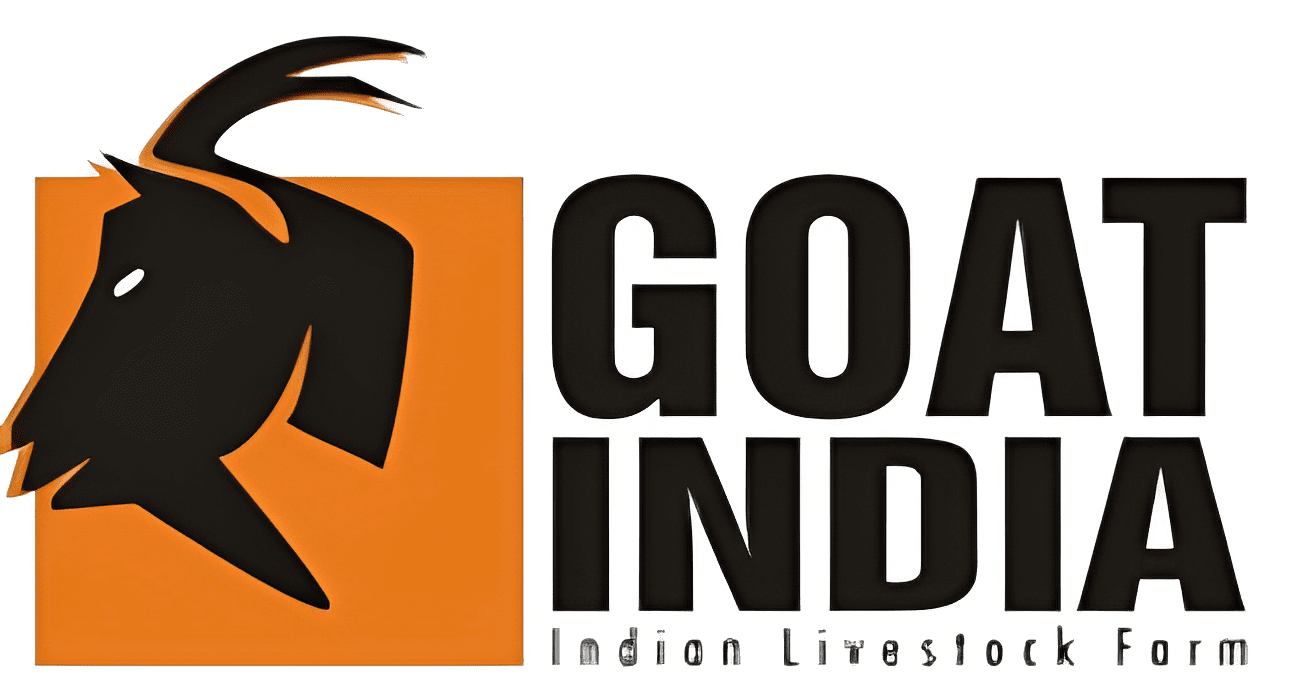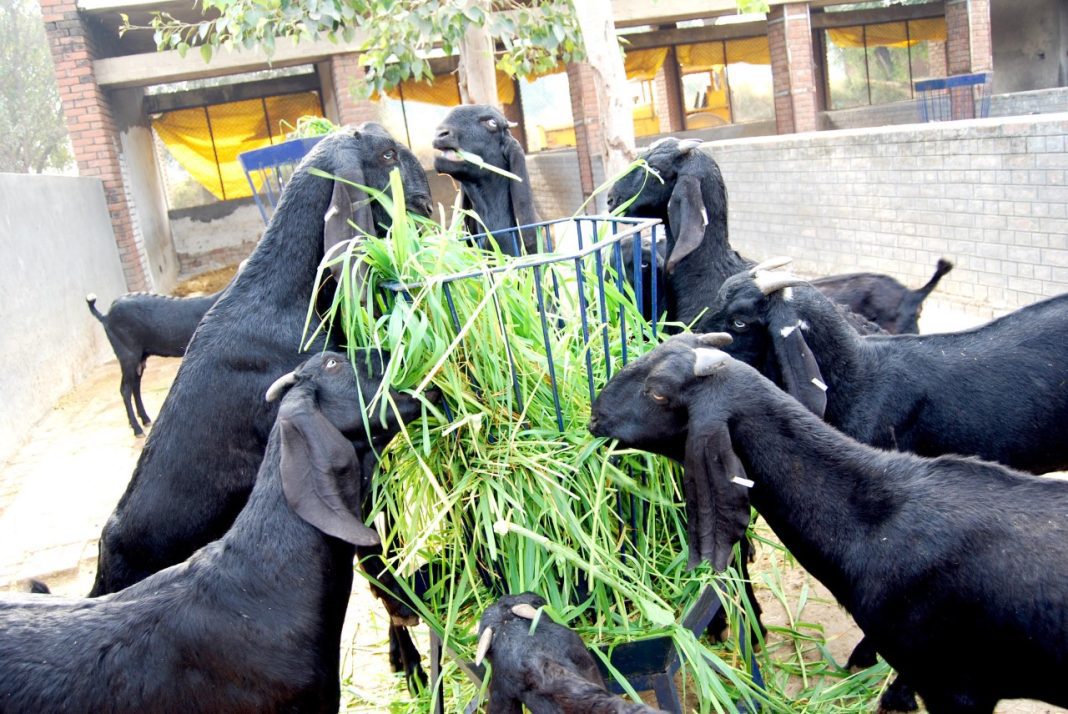Goat Feeding & Nutrition Guide
Master the science of goat nutrition with practical feeding strategies, balanced diet formulations, and expert recommendations for optimal health and productivity in Indian farming conditions.
Nutrition Impact Statistics
Proper nutrition directly affects goat health, milk production, and farm profitability
Comprehensive Feeding Guide
Essential Nutrients
Protein: 12-16% of total diet for adults, 18-20% for growing kids
Energy: 60-65% digestible organic matter for maintenance
Minerals: Calcium 0.4%, Phosphorus 0.3%, Salt 0.5%
Vitamins: Focus on Vitamin A, D, and E supplementation
Daily Water Requirements
Adult Goats: 3-4 liters per day in normal weather
Lactating Does: 6-8 liters per day during peak lactation
Kids (3-6 months): 1-2 liters per day
Summer: Increase water supply by 40-50%
Dry Matter Intake
Adult Goats: 3-4% of body weight daily
Growing Kids: 4-5% of body weight daily
Pregnant Does: Increase by 25% in last trimester
Lactating Does: 4-6% of body weight daily
Digestive Considerations
Rumen Development: Focus on roughage for healthy rumen
pH Balance: Maintain rumen pH between 6.0-7.0
Fiber Requirement: Minimum 15% crude fiber in diet
Concentrate Ratio: Maximum 40% of total diet
Expert Tip
Always provide fresh, clean water. Dehydration can reduce milk production by up to 50% and severely affect feed conversion efficiency. Install automatic waterers where possible.
Green Fodder
Berseem: High protein (18-20%), excellent for lactating does
Lucerne: Protein king (22-25%), rich in minerals
Cowpea: Good summer fodder, 16-18% protein
Maize Fodder: Energy-rich, palatable, 8-10% protein
Dry Fodder & Straws
Wheat Straw: Basic roughage, 3-4% protein
Rice Straw: Low protein (2-3%), needs supplementation
Gram Straw: Better protein content (6-8%)
Groundnut Straw: High quality roughage, 10-12% protein
Concentrate Feeds
Wheat Bran: 15-16% protein, good palatability
Rice Bran: 12-13% protein, energy-rich
Groundnut Cake: 45-48% protein, premium supplement
Cottonseed Cake: 22-24% protein, cost-effective
Tree Leaves & Browse
Subabul: 20-25% protein, good digestibility
Neem: Medicinal properties, moderate protein
Drumstick: High protein, vitamins, minerals
Banyan Leaves: Traditional feed, good palatability
| Feed Type | Protein % | Energy (TDN %) | Cost Rating | Availability |
|---|---|---|---|---|
| Berseem (Green) | 18-20% | 65-70% | Medium | Winter Season |
| Lucerne Hay | 16-18% | 55-60% | High | Year Round |
| Groundnut Cake | 45-48% | 75-80% | High | Year Round |
| Wheat Straw | 3-4% | 40-45% | Low | Post Harvest |
Adult Maintenance Diet
Morning (6 AM): Green fodder 1-1.5 kg
Afternoon (12 PM): Dry fodder 0.5 kg + concentrate 200g
Evening (6 PM): Green fodder 1-1.5 kg
Total Daily: 2.5-3 kg fodder + 200-250g concentrate
Lactating Doe Diet
Base Diet: Maintenance + production requirement
Concentrate: 300-400g per liter of milk
Green Fodder: 4-5 kg per day
Additional: Mineral mixture 10g, salt 5g
Kid Feeding Program
0-3 Months: Mother’s milk + starter feed from 3 weeks
3-6 Months: Weaning diet, 16-18% protein concentrate
6-12 Months: Grower diet, quality fodder + 200-300g concentrate
Daily Intake: 4-5% of body weight as dry matter
Breeding Buck Diet
Base Requirement: Maintenance + 25% extra
Breeding Season: Additional 200g concentrate
Protein Level: 14-16% of total diet
Special Needs: Vitamin E and zinc supplementation
Important Feeding Guidelines
Never make sudden feed changes. Gradually transition over 7-10 days to prevent digestive upset. Always feed at regular times to maintain rumen health and optimal digestion.
Mineral Supplements
Commercial Mineral Mix: 10-15g per adult goat daily
Salt: 5-8g per goat per day (common salt)
Calcium: Extra during pregnancy and lactation
Phosphorus: Essential for bone development and milk production
Vitamin Requirements
Vitamin A: Green fodder provides adequate amounts
Vitamin D: Sunlight exposure essential
Vitamin E: Important for reproductive health
B-Complex: Usually synthesized in rumen
Probiotics & Enzymes
Probiotics: Improve feed conversion by 8-12%
Digestive Enzymes: Help break down fibrous feeds
Yeast Culture: Enhances rumen fermentation
Organic Acids: Maintain gut health and pH
Herbal Supplements
Ashwagandha: Improves immunity and reproduction
Turmeric: Natural antibiotic and anti-inflammatory
Neem Powder: Deworming and digestive health
Amla Powder: Vitamin C source and immunity booster
Supplementation Schedule
Provide mineral supplements consistently. Mix with feed rather than offering separately. Monitor goats for deficiency symptoms like poor coat, reduced appetite, or low milk production.
Practical Feeding Techniques
Evidence-based feeding practices for Indian goat farming conditions
Feed Storage & Management
Moisture Control: Store feeds with less than 12% moisture to prevent mold growth and nutrient loss.
Pest Control: Use sealed containers and regular cleaning to prevent rodent contamination.
Quality Testing: Check feeds regularly for freshness, especially during monsoon season.
Inventory Rotation: Follow first-in, first-out principle to maintain feed quality.
Seasonal Feeding Strategies
Summer: Increase water supply, provide shade, feed during cooler hours (early morning/evening).
Monsoon: Focus on dry fodder quality, prevent mold, ensure proper drainage in feeding areas.
Winter: Increase energy feeds, provide windbreak, maintain body condition for breeding season.
Spring: Utilize fresh green fodder, gradually transition from stored feeds.
Feed Efficiency Monitoring
Feed Conversion: Track feed intake vs. milk production or weight gain weekly.
Body Condition: Maintain score 2.5-3.5 on 5-point scale throughout production cycle.
Milk Components: Monitor fat and protein levels to ensure balanced nutrition.
Cost Analysis: Calculate feed cost per liter milk or per kg live weight gain.
| Feed Processing Method | Digestibility Improvement | Cost Impact | Best For |
|---|---|---|---|
| Chopping (2-3 cm) | 10-15% | Low | All roughages |
| Steam Treatment | 15-20% | Medium | Poor quality straws |
| Urea Treatment | 20-25% | Low | Paddy/wheat straw |
| Complete Feed Blocks | 25-30% | High | Commercial operations |
Nutritional Guidelines by State
| State | Primary Fodder | Common Concentrates | Seasonal Challenges | Local Solutions |
|---|---|---|---|---|
| Rajasthan | Bajra stover, Guar, Khejri pods | Bajra, Gram, Groundnut cake | Water scarcity, heat stress | Desert grass, cactus feeding |
| Punjab | Berseem, Oats, Maize fodder | Wheat bran, Rice bran | Excess moisture in monsoon | Silage making, hay preservation |
| Maharashtra | Sorghum, Sugarcane tops | Cotton seed cake, Jowar | Drought periods | Crop residue utilization |
| Gujarat | Lucerne, Groundnut stover | Groundnut cake, Cotton seed | Salt water intrusion | Hydroponic fodder systems |
| Tamil Nadu | Sorghum, Cumbu, Coconut fronds | Rice bran, Coconut cake | Cyclones, flood damage | Tree fodder, silage systems |
Regional Veterinary Consultation
Feed composition and nutritional needs vary by region, climate, and local goat breeds. Always consult your local veterinarian or animal husbandry department for region-specific feeding recommendations and government subsidy programs.
Start Implementing Scientific Nutrition Today
Transform your goat farming with evidence-based feeding practices that increase productivity while reducing costs


